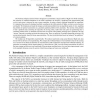Free Online Productivity Tools
i2Speak
i2Symbol
i2OCR
iTex2Img
iWeb2Print
iWeb2Shot
i2Type
iPdf2Split
iPdf2Merge
i2Bopomofo
i2Arabic
i2Style
i2Image
i2PDF
iLatex2Rtf
Sci2ools
ALENEX
2008
2008
Geometric Algorithms for Optimal Airspace Design and Air Traffic Controller Workload Balancing
The National Airspace System (NAS) is designed to accommodate a large number of flights over North America. For purposes of workload limitations for air traffic controllers, the airspace is partitioned into approximately 600 sectors; each sector is observed by one or more controllers. In order to satisfy workload limitations for controllers, it is important that sectors be designed carefully according to the traffic patterns of flights, so that no sector becomes overloaded. We formulate and study the airspace sectorization problem from an algorithmic point of view, modeling the problem of optimal sectorization as a geometric partition problem with constraints. The novelty of the problem is that it partitions data consisting of trajectories of moving points, rather than static point set partitioning that is commonly studied. First, we formulate and solve the 1D version of the problem, showing how to partition a line into "sectors" (intervals) according to historical trajector...
Airspace Sectorization Problem | ALENEX 2008 | Algorithms | National Airspace System | Workload Limitations |
| Added | 29 Oct 2010 |
| Updated | 29 Oct 2010 |
| Type | Conference |
| Year | 2008 |
| Where | ALENEX |
| Authors | Amitabh Basu, Joseph S. B. Mitchell, Girishkumar Sabhnani |
Comments (0)

